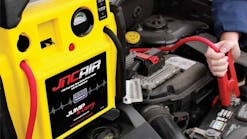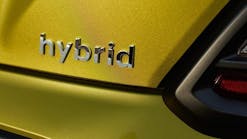Guest Blog: Vehicle battery maintenance for the winter
It might seem like batteries are somewhat unpredictable, and in some ways, they can be. While the two most common killers of batteries are heat and time, the winter cold is often the final straw that exposes underlying battery weakness. And it doesn’t always take a polar vortex to cause battery problems. Technicians must take the time to talk with their customers about how to prevent premature battery demise this winter. First, by advising them to bring their vehicles in for battery maintenance, and second, by educating their customers on practices they should adopt to get through the winter without a battery failure related incident.
Clore Automotive has created two checklists that will aid technicians in what to look for for the battery maintenance check as well as the advice they can offer their customers.
Technician checks
1. Check for corrosion while it’s still fall
Corrosion on the battery terminals will keep the cables from making contact with the terminals correctly. That might prevent the electricity from flowing and a vehicle from starting. Checking to make sure corrosion won’t prevent the vehicle from starting before the weather cools off might just save you some headaches later on.
Before you scrub it off, it’s probably worth taking a look at the types of corrosion that are forming on a lead acid battery’s terminals. White, powdery corrosion on the negative terminal might be due to sulfation, which means that the battery is undercharged and may have lost a significant amount of its energy storing capacity. Bluish-green corrosion is generally copper sulfide, which is going to greatly reduce the flow of energy from the battery to the starter or from the alternator to the battery.
Cleaning off these terminals is one way to help the battery not have to struggle so hard this winter. Terminals can be cleaned with a stiff wire brush and a mixture of baking soda and very hot water. Remember to clean the interior of the terminal connections, not just the exterior surface. When disconnecting the battery to remove corrosion from the interior surfaces of the terminals, it is best to connect a memory saver, such as a Booster PAC or Jump-N-Carry jump starter with Clore Automotive’s ESA30 memory saver cord, to the vehicle to preserve learned memory and electronic presets. After you’ve cleaned the terminals, add some grease to help prevent corrosion in the future.
2. Test the battery’s health
Giving the battery a quick test is a good idea as the winter weather approaches. Find out if the battery is weak. If it is, it’s worth discussing with your customer replacing it sooner rather than later. Because, let’s be honest, it won’t be getting any stronger as the temperatures drop. A quality digital tester, such as Clore’s SOLAR BA9 or BA6 models, can provide an assessment of battery health, as well as starter and charging system functions. Best to do a thorough check for your customers and fix any issues lurking in their vehicle’s electrical system.
3. Give it a charge
Even if the battery checks out okay in the above test, it’s best to recommend seasonal preventive maintenance charging to your customers. This can be done using a quality smart charger, like Clore’s PRO-LOGIX PL2320. If your customers ask why this is necessary, here are a few reasons you can give them:
First, depending on their driving patterns, it is very possible that the battery is not regularly getting a full charge, resulting in it often sitting in a slightly or moderately discharged state. This is detrimental to the battery’s long-term health.
Second, it is possible that their vehicle’s charging system is not providing the most beneficial charge possible, especially if they have replaced the original battery.
Finally, winter functions such as heated seats and window defrosters combined with slower, longer commutes can put a strain on the battery and charging system. A periodic maintenance charge will bring the battery back to full charge in a beneficial manner and restore reserve capacity, potentially even reversing light sulfation build-up on the battery’s plates.
4. Check the other critical systems of the vehicle
Winter cold is hard on all vehicle systems, not just the battery and starting/charging system. To avoid dangerous breakdowns at the worst time of the year, it is best to check all major systems and perform required preventive maintenance. This includes checking/changing the oil and filter, flushing the cooling system, checking the tires and brakes, and replacing the wiper blades.
Advice for customers
1. Take it easy on the battery
Many of the accessories running in vehicles today aren’t particularly easy on an already taxed vehicle power system that is pushing battery performance to its extreme. With an abundance of power-hungry devices built right into our cars, it’s easier than ever to use up more power than we should without even noticing it. This is particularly true of “always-on” aftermarket devices, such as aftermarket anti-theft systems or aftermarket driving monitors. When adding these devices to your system, take care to ensure that they do not create parasitic drains on your vehicle’s battery when it is turned off. Such drains hurt the battery in two ways:
- They increase the likelihood of a dead battery if the vehicle sits unused for any length of time, say 2 to 3 days.
- They bring battery voltage down into the range where sulfation will accelerate, causing long term harm to the battery.
2. Carry a jump starter
Having a self-sufficient method of starting your car is one sure-fire way to know that it can handle whatever winter throws at you, whenever and wherever you are. Having a jump starter in your trunk can help you avoid major setbacks and keep winter battery problems from putting your day’s plans on hold. It is a good idea to ensure that all family members have an understanding of how to use the jump starter so that they can safely utilize it when needed. Remember to charge your jump starter per the manufacturer’s guidelines. It is recommended that you recharge every 90 days, regardless of the type of jump starter you own (lead-acid, lithium, etc.). Clore Automotive offers jump starter recharge alerts, that you can sign up for here.
3. Have an emergency kit in the vehicle
Despite your best preparation, you may still find yourself in an emergency situation. It is best to have an emergency kit prepared so that an inconvenient or minor situation doesn’t turn far worse because you aren’t prepared to deal with the extreme winter cold. Your emergency kit should include a jump starter, a work light, flares, gloves, boots, and blankets.
Winter is hard on a vehicle battery but advising customers to be prepared and come in for a battery maintenance check-up should help them avoid becoming a victim of winter battery issues and overcome unforeseen problems if they did arise. Safety and preparation go hand in hand when it comes to being prepared to operate a vehicle in harsh winter weather.
Information provided by Clore Automotive


